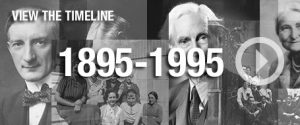The 2018 LSE Festival was a programme of events 19-24 February on the theme “Beveridge 2.0: rethinking Beveridge for the 21st century”. What was life at LSE like while Sir William Beveridge was Director? What happened to LSE during World War II? How did Beveridge’s former LSE colleagues interact with the report in later years? Explore our collection of stories from LSE’s history.
Meet William Beveridge
William Beveridge was born in India in 1879 to British parents who worked in the Indian civil service. The family spent time in both India and Britain, before the final decision to move back to Britain in 1890. After attending Charterhouse school and Balliol College Oxford, Beveridge had spells at Toynbee House, a centre for social outreach in the East End of London, and the Morning Post where he began pursuing a career in social reform. His work on unemployment at this time found favour with Beatrice and Sidney Webb and Winston Churchill, and he was invited to join the Board of Trade in 1908. During World War I Beveridge was largely in food administration and rationing. He was unsure about its future post-war, when Sidney Webb suggested he apply for the LSE directorship.
Beveridge became LSE’s first post-war director in 1919 with the legacy of the First World War shadowing the School, and left nearly 20 years later as the Second World War loomed ahead. During his time at LSE, Beveridge set about expanding the School’s premises on the Clare Market site to include Houghton Street; championed sports and established a sportsground; increased LSE’s teaching remit; set up the Academic Assistance Board for refugee scholars; secured financial donations from the Rockefellers in the USA; and served as Vice Chancellor of the University of London. His LSE colleagues included now-famous individuals such as Eileen Power, Lionel Robbins, RH Tawney, Hugh Dalton, Josiah Stamp and Harold Laski.
A difficult last few years at LSE revolved around issues of academic freedom; the perceived favouritism of social biology as an academic path; and reactions to the management style of both Beveridge and secretary Jessy Mair. Beveridge’s initial move was to become master of University College, Oxford but his real skill was in research and evidence-based long term strategies for social reform. During the war he was eventually assigned to work on social insurance. In 1942 he published the Report on Social Insurance and Allied Services, known as the Beveridge Report, which was a proposal for Britain’s first universal care system. The report sought to tackle the five “giants” of disease, want, squalor, idleness and ignorance and became wildly popular with the British public.
Further information
LSE History blogs about William Beveridge
William Beveridge: a biography by Jose Harris
A History of the London School of Economics and Political Science 1895-1995 by Ralf Dahrendorf



